Driving through a driveway lined with trees on either side can be exciting and picturesque.
You may be tempted to face-lift your driveway in the same way when you realize the appeal of such scenery.
There are many beautiful trees in existence. Therefore, there are many options from which you can make a choice, but it’s not so simple as just choosing the prettiest tree.
These trees thrive best under certain conditions. Besides, each one offers certain unique features that may appeal to you more than the others.
But not to worry, we have done the research for you. We have compiled a list of some of the most beautiful trees for your driveway.
As we explore these trees, we will talk about the best zones for them, their physical features, and much more.
Table of Contents
Types of Trees You Can Use for Your Driveway
There are 3 main classes of trees you can use for your driveway, and each one comes with different pros and cons.
1. Wide Canopy Trees

Wide-Canopy Trees come with extensive aboveground structures.
They may also be called Shade Trees. This type of tree shields the floor beneath them from sunlight, thanks to their extensive canopies.
By reducing the amount of sunlight that gets to the floor, wide canopy trees can create a beautiful contrast on your driveway.
Examples of this type of tree include the Chinese Elm tree, Maple, and Birch tree.
Pros
- They provide shade, and this can help maintain lower temperatures on very sunny days.
- By shielding asphalt road from sunlight, they can lengthen the lifecycle of such roads.
- They can serve as a shield against rain and wind.
- It can help in controlling road noise pollution.
Cons
- Many shade trees are deciduous. But at the end of their growing season, you have a lot of litter on the driveway as they drop their leaves.
2. Flowering Trees (Ornamental Trees)

Flowering trees are ornamental trees. They bloom flowers that give them an overall appealing look.
Flowering trees can be a great addition to your driveway as they make for beautiful entry trees.
You’ll find that some even change the color of their flower with the season.
These types would add dimension to the scenery of your landscape. The periodical color change can be interesting to watch.
Pros
- They keep your driveway beautiful year-round.
- They can easily give your drive a facelift.
- They can boost the value of your property.
- They attract birds; the sound of chirping birds can add some dimension to the scenic serenity.
Cons
- They are typically smaller than shade trees, so you won’t get as much shade.
- When the leaves and flowers drop, cleaning up would require extra effort.
3. Evergreen Trees
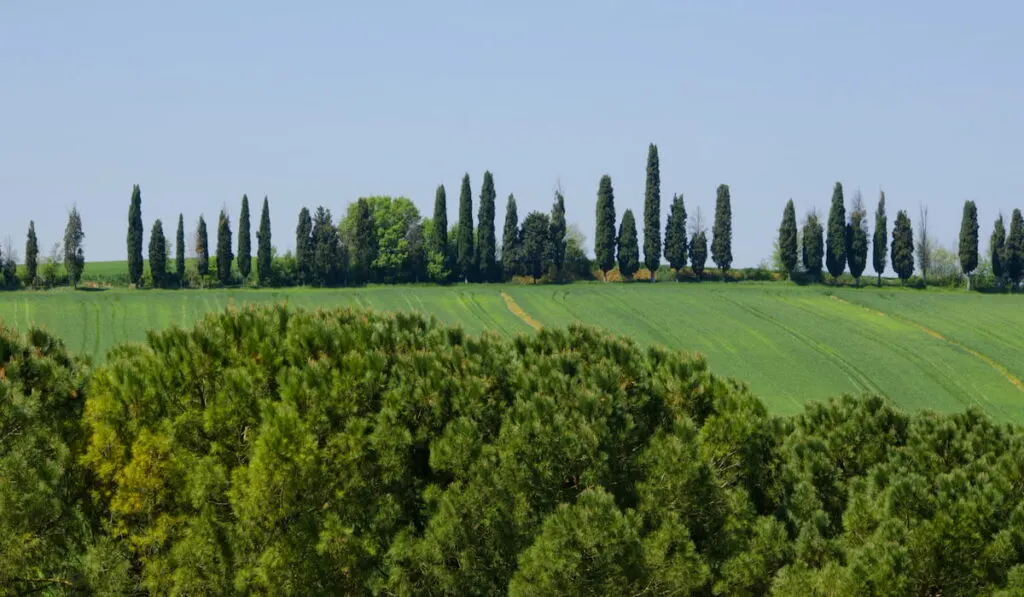
Evergreen trees are as they are named; they stay green throughout the year.
Of course, since they stay green year-round, the beauty, privacy, and shade they offer will always be present on your driveway.
Examples of Evergreen trees include Norway Spruce, American Holly, and Leyland cypress.
Pros
- They retain their appeal year-round.
- Since they remain green throughout the year, you will rarely get litter.
- They offer some privacy.
Cons
- Some evergreen trees grow very fast; they become bushy and ragged quickly. So, you may have to prune them quite frequently.
- If you ever want to replace, you may have it hard. Evergreens are hardy, and getting rid of them can be tough.
9 Beautiful Trees for Your Driveway
1. Dogwood
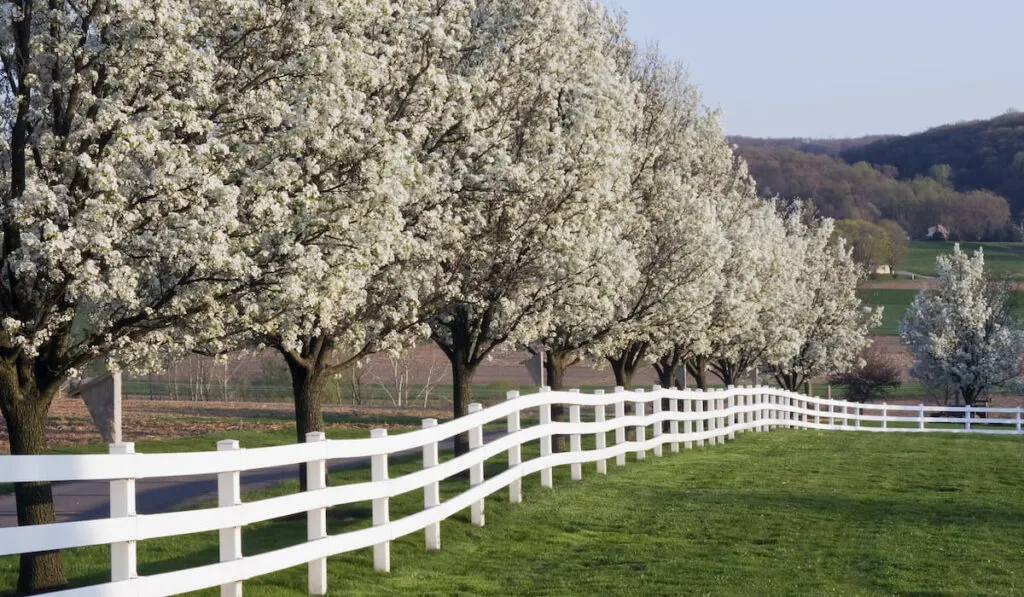
There are various types of dogwood trees, and they all bloom white or pink flowers as spring comes.
When the flowers are in full bloom, they just cannot be ignored. Much of the beauty dogwood trees offer is better seen than said.
Dogwood trees grow in zones 5 to 9, and on average, they reach heights between 10 and 25 feet.
Dogwood trees are fast growers; they can add up to a foot within a year.
While many species of Dogwood are pretty cold hardy, some are not. The Cornus florida, for instance, would not do well in colder zones.
2. Pear Tree

The Pear tree can grow as tall as 40 feet; it also has a semi-dwarf variety that grows as tall as 12 feet.
The Pear tree is also flowering, so you can expect appealing scenery when they bloom in early spring.
Their flowers are white with 5 petals, and they give an icy look from afar – something to enhance your driveway.
Pear trees thrive in zones 3 to 10. They are fast growers and are pretty frost-tolerant.
3. Red Maple
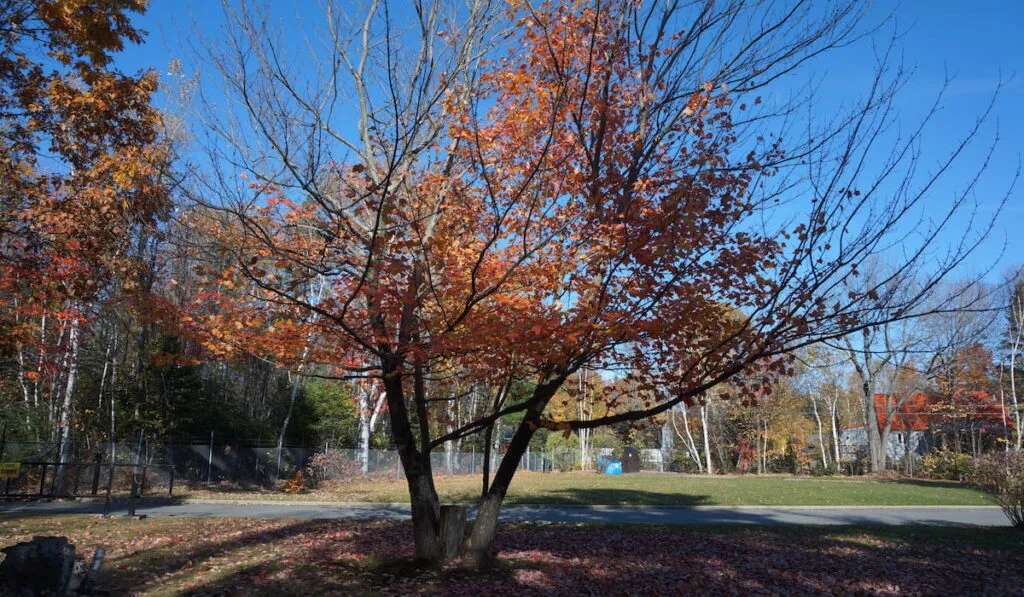
Red Maple is an option if you want an ornamental tree. The leaves, stems, and flowers of this maple tree change with the season. They all turn green during the fall.
Red Maple trees are suited for zones 3 to 9. They grow to 40-60 feet in height, with a spread of up to 40 feet.
You may expect height increases between 13 and 24 inches since they are medium to fast growers.
4. Purple Leaf Plum
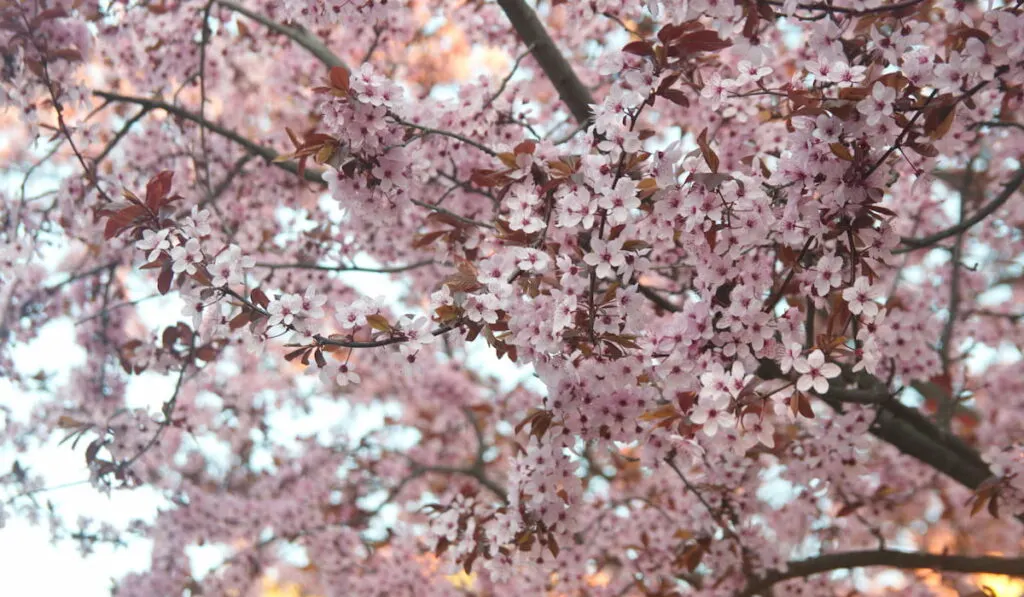
The Purple Leaf Plum is an ornamental tree; it comes with purple leaves and white or pink flowers to adorn its appearance.
The flowers typically show up in spring.
Without sunlight, your Purple Leaf Plum may not grow purple leaves.
In fact, you may get green leaves instead. So, take note of this while planting.
Purple Leaf Plum trees reach heights of up to 25 feet, with a spread of 25 feet.
They thrive in zone 4 to 9, but most species do even better in zones 5 to 8.
Purple Leaf Plum trees have a medium growth rate; they grow by around 1-2 feet per year.
5. Apple Serviceberry
The Apple Serviceberry is a flowering tree that also changes color with the seasons.
With Apple Serviceberry trees, you actually get a color show in more seasons than one.
The white flowers bloom just before the leaves show up in spring. Then as fall approaches, the blue-green leaves become orange.
When the tree is young, they have reddish-brown bark. But when they grow older, the bark turns greyish-brown.
The fruits also transform from green to red or purple when the tree is mature.
So, with the Apple Serviceberry, it is a color show.
Apple Serviceberry trees thrive in zones 4 to 9 and have a fast growth rate.
They reach heights and widths of 20-25 feet and are frost resistant to about -25 F.
6. Quaking Aspen
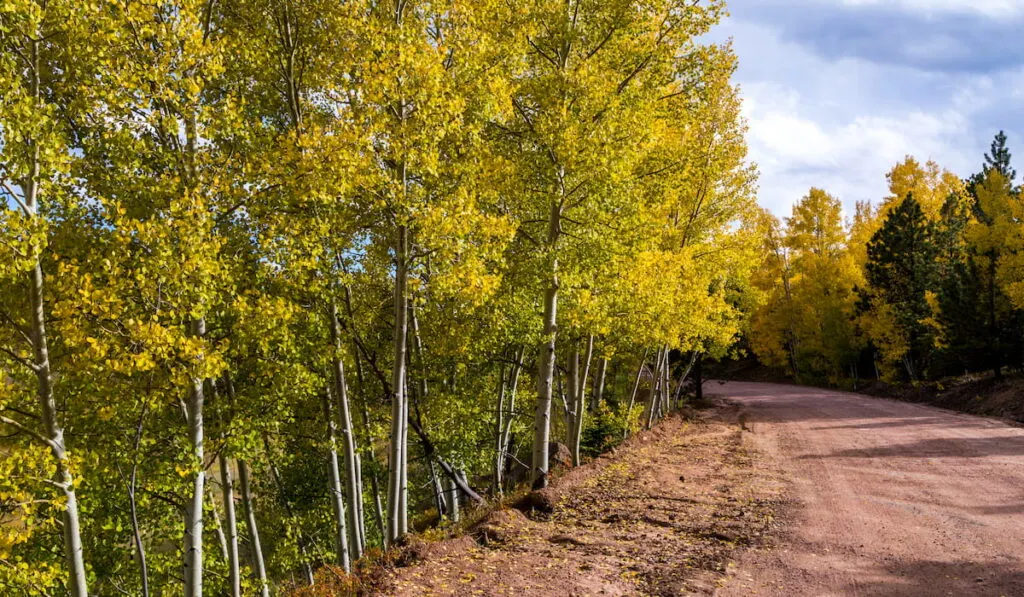
If you want a tree that grows very fast, then the Quaking Aspen is a choice to consider. This tree grows by at least 24 inches every year.
The leaves of the Quaking Aspen are a delight, and when fall comes, they turn yellow, adding even more appeal.
The color is not all you get as the leaves, which have flattened petioles, are easily moved by light breeze.
On average, Quaking Aspens grow up to 40-50 feet while spreading 20-30 feet.
They thrive in zones 1 to 7, and they adapt to cold through various structural adaptations.
7. Sugar Maple
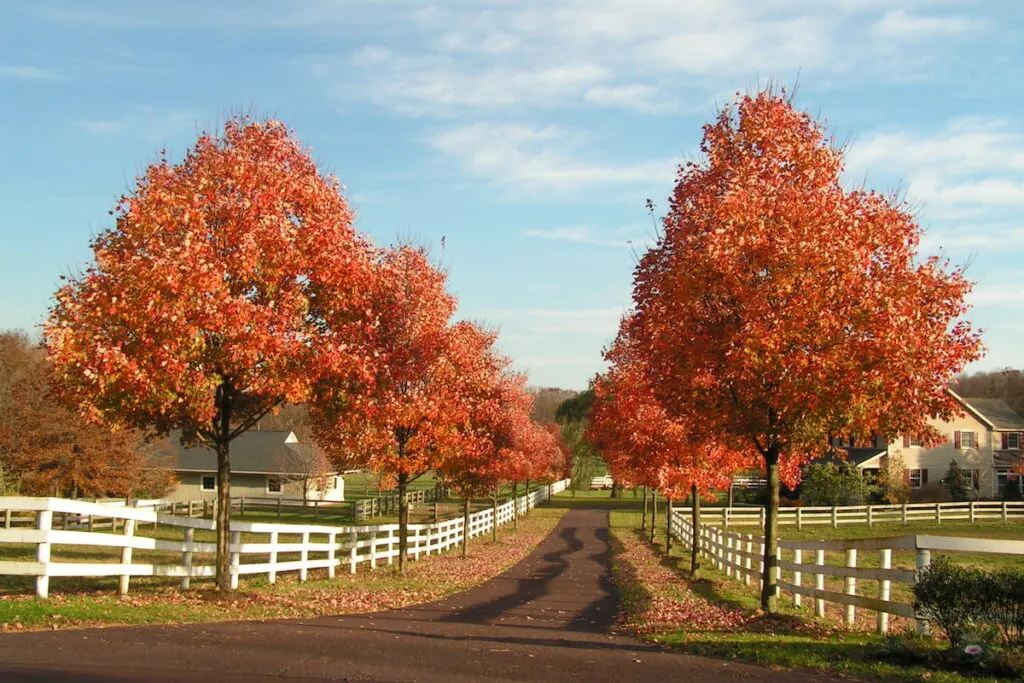
You may know the Sugar Maple leaf from the Canadian flag, New York, Vermont, Wisconsin, and West Virginia.
Well, besides the Sugar Maple tree being symbolic in some places in North America, it could also be the symbol of your driveway.
The Sugar Maple tree is one of those trees that change colors with the seasons.
Its leaves, which are usually green, become red, yellow, or burnt orange in the fall. So, you do not have to be stuck with green all year round.
Sugar Maple trees grow as tall as 60-75 feet, with a spread of 40-50 feet. They are not fast-growers; you can expect a slow to medium growth rate.
Sugar Maples typically add around 12-24 inches yearly. If you want to grow them, zones 3 to 8 give the best outcomes.
Sugar Maple trees are cold tolerant down to zone 3.
8. Vine Maple
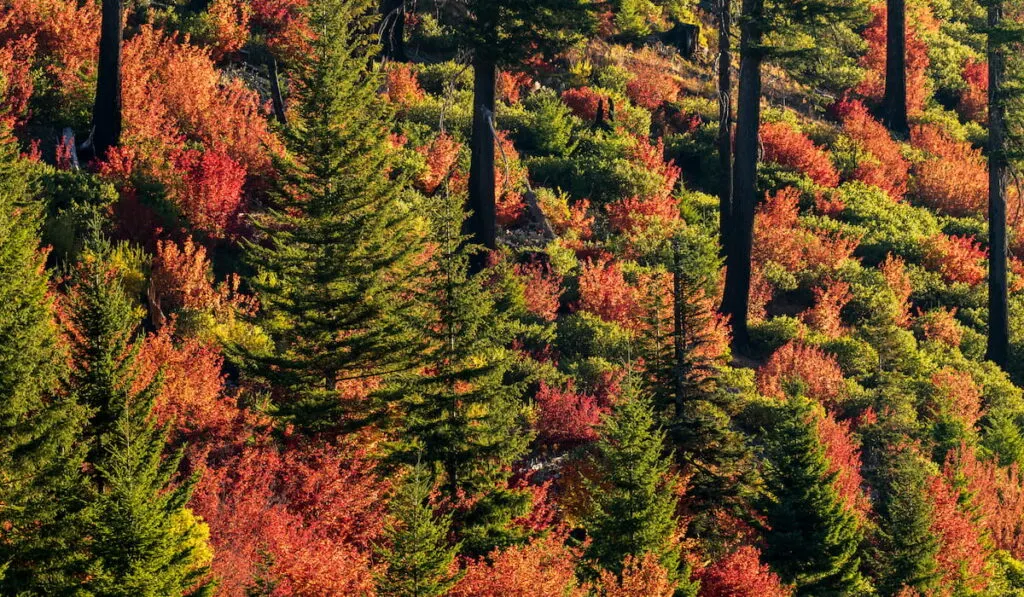
Like the Sugar Maple, the Vine Maple is native to Canada. To be more specific, this tree is native to the Pacific Northwest.
It is an ornamental tree that changes color with the seasons and would give your driveway some aesthetic.
The bright-green or pale-green leaves turn yellow or scarlet orange in the fall. The outcome of this transformation is certainly vivid.
Vine Maple trees grow as tall as 20-35 feet. They thrive in zones 5 to 9 and have a slow to moderate growth rate.
9. Chinese Elm Tree
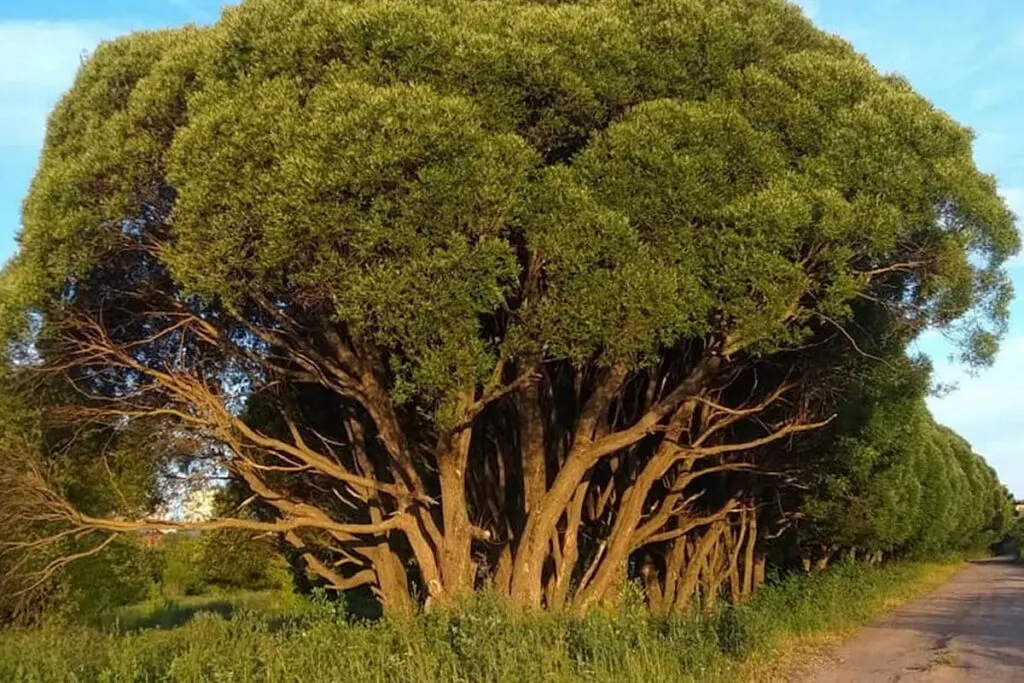
The Chinese Elm tree is a shade tree. It is also evergreen, but in some regions, the leaves change colors in fall.
Leaves of the Chinese Elm Tree can change to yellow, purple, or red.
Chinese Elm trees can reach up to 80 feet. But the average range falls between 40 and 50 feet. They are fast growers, and they thrive in zones 5b-10a.
Chinese Elm trees can be frost-tolerant. However, this all depends on where you get them from.

Resources
- https://www.landscape-design-advice.com/trees-for-driveways.html
- https://www.landscape-design-advice.com/landscape-trees.html
- https://www.gardendesign.com/trees/fall-color.html
- https://cid-inc.com/blog/forest-plant-canopy-analysis-tools-methods/
- http://madisoncanopystreettrees.org/development/canopy-tree-benefits/
- https://www.twinoakslandscape.biz/nine-benefits-of-having-fruiting-and-flowering-trees/
- https://www.cdslandscapingandtreeservice.com/not-sure-about-landscaping-with-evergreens-the-pros-and-cons
- https://www.arborday.org/trees/treeguide/treedetail.cfm?itemID=870
- https://www.gardeningknowhow.com/garden-how-to/gardening-by-zone/zone-4/maple-trees-for-zone-4.htm
- https://www.arborday.org/trees/treeguide/TreeDetail.cfm?ItemID=780
- https://www.fws.gov/
- https://www.mortonarb.org/trees-plants/tree-plant-descriptions/apple-serviceberry
- https://bernheim.org/learn/trees-plants/bernheim-select-urban-trees/apple-serviceberry/
- https://pfaf.org/plants/apple-serviceberry-juneberry-amelanchier-lamarckii/
- https://www.monrovia.com/vine-maple.html
- https://www.monrovia.com/autumn-brilliance-apple-serviceberry.html
- https://emswcd.org/vine-maple/
- https://www.gardendesign.com/trees/dogwood.html
- https://www.gardeningknowhow.com/garden-how-to/gardening-by-zone/zone-4/zone-4-dogwood-trees.htm
- https://edis.ifas.ufl.edu/st652
- https://www.bonsaiempire.com/tree-species/chinese-elm
- https://www.almanac.com/plant/pears
- https://www.gardeningknowhow.com/edible/fruits/pear/getting-a-pear-tree-to-bloom.htm
- https://homeguides.sfgate.com/freezeresistant-fruit-nut-trees-60890.html
- https://www.arborday.org/trees/treeguide/treedetail.cfm?itemID=867
- https://www.gardendesign.com/trees/purple-leaf-plum.html
